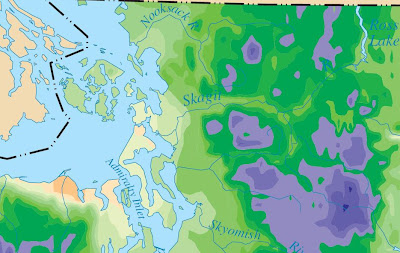"...Snowpack Analysis
INSTALLING SPRING...
███████████████░░░░░░░░░░░░░░░
███████████████░░░░░░░░░░░░░░░
Installation delayed....please wait.
Installation failed. Please try again. 404 error: Season not found.
Season "Spring" cannot be located. The season you are looking for might
have been removed, had its name changed, or is temporarily unavailable.
Please try again.
++++++++++++++++++++++++++++++
Continued cool to cold temperatures with periodic showers has been the weather pattern over the past four days, well a lot longer actually, but we'll focus on this week for now. Last weekend a frontal passage was accompanied by moderate warming and precipitation that caused a fairly extensive avalanche cycle of new storm snow slab avalanches and many wet loose slides..."
Weather guru Cliff Mass's blog entry for 4/15/2011 says
"2011 is clearly the worst year on record with the fewest number of days above 55F!!!...You would have to go back to the 1950s to find the runner up..."
Last weekend, I went up to Racehorse Mountain near Deming to try out a new pair of snowshoes. Normally, I hate snowshoeing but they're good for crappy snow and on steep, timbered slopes that are un-skiable. Snow blocked the road at 2300 feet elevation which is unusual for mid-April. However, all the snow was relatively new not more that a month old in my estimation. You could probably drive higher last winter when the snowline was higher. The winter weather was almost-mild until late February or early March and it's been wet and cool ever since. This is not good for access to the higher mountains.
When it's topping out at 35 degrees F at Heather Meadows on Mt Baker with a few inches of snow almost daily, that means wet, heavy sticky snow in the afternoon that is difficult to ski and increased avalanche hazard. Snowlines have been dropping down too. This is kind of a good thing because it means snow at higher elevations will be lighter and fluffier so better for skiing. However, that also means low elevation snow (defined as 2-3000 feet) blocks gravel roads that access touring areas. So, we have not been doing much backcountry skiing or snowshoeing even though there is a lot of snow.
Every year, like most people, I look forward to spring . In the Cascade mountains, there can be excellent spring ski touring once several freeze-thaw cycles occur and "corn snow" forms. Turns-all-year.com says,
"Here in the Pacific Northwest, we are blessed with deep winter snows and long cool springs which help preserve the mountain snowpack, making possible year-round skiing. Summer skiing in the Cascades can provide some of the nicest backcountry conditions of the year: a fast, consolidated, and consistent snowpack; warm, sunny weather; and long hours of daylight...".
Snowpack stabilizes in spring so avalanche hazard drops. But, this year the North Cascades are currently stuck in between winter and spring.
There's not much freezing and thawing of the snowpack so almost no corn snow so far this April of 2011. Yesterday's forecast says it'll alternate between regular winter snow at night with wet, sticky snow mixed in with rain during the day.

There's a huge snowpack at Mt Baker since it's been snowing almost every day up there. The snowpack is about 150% of the 30 year average! That's an incredible number when you consider than even an average/100% snowpack is very deep and doesn't melt off until late July. High elevation trails like Ptarmigan Ridge may not melt off and be hikable for average folk until mid-August. Whether we get warm, sunny weather this spring and early summer will cause how fast snow melts.
So...for the last few weeks we've been doing low-elevation forest hikes and canoe trips in the partial rain shadow around Anacortes and Bellingham during narrow windows of nice weather. The edge of the Olympic Mountains rain shadow clips the lowlands around Bellingham. But you don't have to go very far from Bellingham to reach soggy rainforest. I consider the forests along the North Fork Nooksack east of Glacier as temperate rainforest.

Canoeing and kayaking is an option when snow and/or weather conditions in the Cascades are not good. Besides river rating difficulty (Class 1, etc.) the big issues with canoeing Pacific Northwest rivers are:
1.) tides
2.) river flow and volume.
When canoeing a river, you must check the river flow as measured in cubic feet per second (cfs). The US Geological Survey has a webpage with past, current and forecasted river flows.
Canoeing bodies of water influenced by the tides can be fun. You can ride the tide out then ride the tide back in. Tides don't always coincide with when you'll be on the water. The National Oceanic Atmospheric Administration has a webpage that forecasts tides. Below is the tide table for the station closest to the Skagit Delta. Paddling the Skagit Delta from the wildlife area headquarters requires a put-in and take-out around high tide. Since the tide is going out quickly starting around 9am and lowest at 5pm, paddling this area from 11am to 4pm is not a good idea so a day-hike would be a better choice.





